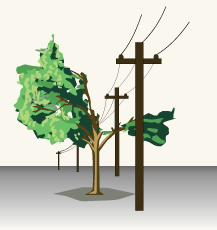In order to provide safe and reliable electric service to our customers, trees must be properly maintained and kept clear of electric power lines. When trees in yards require pruning or removal, the property owner is usually notified before the work begins. Some trees, especially “fast growing” species, may require severe or ongoing pruning when they are located close to power lines. Severe, repetitive pruning is expensive and can impact tree health and appearance. These trees are often selected for removal.
Trees and brush located outside of yards that may grow into electric lines are removed as well. Vines growing on poles, guy wires or other equipment are cut off near the ground.
How Trees are Pruned
Tree care professionals contracted by East Central Energy use ‘directional’ pruning techniques. These techniques were developed by the tree care industry and are published by the American National Standards Institute (ANSI). Directional pruning is the accepted standard and is endorsed by the Arbor Day Foundation and the International Society of Arboriculture. Directional pruning removes entire branches and limbs back to the main trunk of the tree, where trees normally shed them. By using this practice, future tree growth is directed away from power lines and weakly attached re-growth is minimized.
Directional pruning takes advantage of strong points in the tree’s structure. Branches growing away from electric lines or facilities with adequate line clearance are usually left undisturbed. Directional pruning does not harm the tree’s natural defense systems and other natural processes that protect the tree from decay and aggressive re-sprouting. East Central Energy’s contract tree crews use this procedure for pruning trees in yards.
Before branches growing near electric lines are removed, pruning crews evaluate a tree’s structure and growth patterns. Crews also consider the tree species, growth rates common to our region, proximity to electric lines and the height and voltage of the lines.
Directionally pruned trees may appear misshapen. In the long run, however, such trees are less susceptible to pest and decay problems and less likely to drop branches and cause damage during storms. In fact, compared to other methods such as topping, stubbing or pollarding, directional pruning is better for the protection of the tree’s health. Where very severe pruning is necessary to obtain satisfactory clearance, tree health and appearance will be affected and the tree should be selected for removal.

Managing vegetation is becoming an increasingly costly component of providing reliable electrical service. ECE appreciates your understanding and cooperation in completing this important work.
